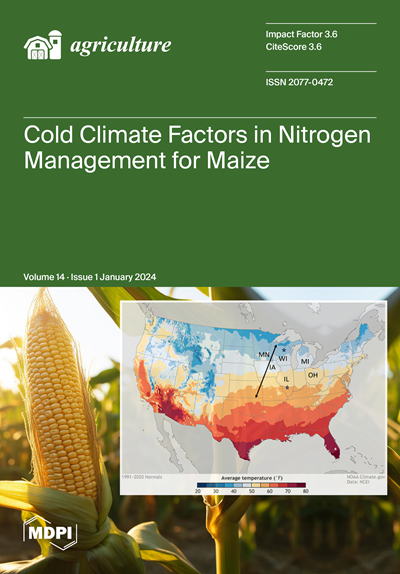气候变化背景下毒死蜱、吡蚜酮和阿维菌素在中国的应用对环境和人类健康的危害
IF 3.3
2区 农林科学
Q1 AGRONOMY
引用次数: 1
摘要
几十年来,毒死蜱被广泛用于控制作物害虫和传播疾病的昆虫;它对提高粮食安全和尽量减少疾病传播的贡献有据可稽。吡蚜酮和阿维菌素(又称阿维菌素)已被用于替代中国水稻作物中使用的有毒有机磷杀虫剂(如毒死蜱),中国已经出现了农药过度使用的情况。此外,气候变化加剧了农药的使用和污染。因此,农民和社区面临暴露于农药污染的风险。通过环境和生物监测,综述了毒死蜱、吡蚜酮和阿维菌素在中国的污染、暴露和健康风险;它调查从毒死蜱到吡蚜酮和阿维菌素的农药使用变化是否减少了农药污染和对社区和居民的健康危害。此外,本综述还讨论了在气候变化情景下农民大量使用毒死蜱并面临高健康风险的其他国家,是否可以推荐吡虫嗪和阿维菌素的应用。尽管毒死蜱在中国已被禁用,但接触毒死蜱的农民和居民仍在遭受不利的健康影响。当地农民仍然认为毒死蜱是一种有效的杀虫剂,并继续在一些地区非法使用。因此,毒死蜱的浓度水平仍然超过风险阈值,毒死蜱的高毒性在多种环境途径中的出现,由于其长期和广泛的应用,造成了严重的健康影响。目前使用的杀虫剂吡蚜酮和阿维菌素不太可能在环境中积累。水稻水和土壤中用于作物生长的吡蚜酮和阿维菌素不会对公众健康造成重大危害。将农药的使用从毒死蜱改为吡蚜酮和阿维菌素,可以减少农药对环境的污染以及对社区和居民的健康危害。最后,我们建议在越南等其他国家以及加纳等农民仍大量使用毒死蜱的非洲国家使用吡虫嗪和阿维菌素。本文章由计算机程序翻译,如有差异,请以英文原文为准。
Environmental and Human Health Hazards from Chlorpyrifos, Pymetrozine and Avermectin Application in China under a Climate Change Scenario: A Comprehensive Review
Chlorpyrifos has been used extensively for decades to control crop pests and disease-transmitting insects; its contribution to increasing food security and minimizing the spread of diseases has been well documented. Pymetrozine and Avermectin (also known as abamectin) have been used to replace the toxic organophosphate insecticides (e.g., Chlorpyrifos) applied to rice crops in China, where the overuse of pesticides has occurred. In addition, climate change has exacerbated pesticide use and pollution. Thus, farmers and communities are at risk of exposure to pesticide pollution. This study reviews the contamination, exposure, and health risks through environmental and biological monitoring of the legacy pesticide Chlorpyrifos and currently used insecticides Pymetrozine and Avermectin in China; it investigates whether changes in pesticide usage from Chlorpyrifos to Pymetrozine and Avermectin reduce pesticide contamination and health hazards to communities and residents. In addition, this review discusses whether Pymetrozine and Avermectin applications could be recommended in other countries where farmers largely use Chlorpyrifos and are exposed to high health risks under climate change scenarios. Although Chlorpyrifos is now banned in China, farmers and residents exposed to Chlorpyrifos are still experiencing adverse health effects. Local farmers still consider Chlorpyrifos an effective pesticide and continue to use it illegally in some areas. As a result, the concentration levels of Chlorpyrifos still exceed risk-based thresholds, and the occurrence of Chlorpyrifos with high toxicity in multiple environmental routes causes serious health effects owing to its long-term and wide application. The bioaccumulation of the currently used insecticides Pymetrozine and Avermectin in the environment is unlikely. Pymetrozine and Avermectin used in paddy water and soil for crop growth do not pose a significant hazard to public health. A change in pesticide use from Chlorpyrifos to Pymetrozine and Avermectin can reduce the pesticide contamination of the environment and health hazards to communities and residents. Finally, we recommend Pymetrozine and Avermectin in other countries, such as Vietnam, and countries in Africa, such as Ghana, where farmers still largely use Chlorpyrifos.
求助全文
通过发布文献求助,成功后即可免费获取论文全文。
去求助
来源期刊

Agriculture-Basel
Agricultural and Biological Sciences-Food Science
CiteScore
4.90
自引率
13.90%
发文量
1793
审稿时长
11 weeks
期刊介绍:
Agriculture (ISSN 2077-0472) is an international and cross-disciplinary scholarly and scientific open access journal on the science of cultivating the soil, growing, harvesting crops, and raising livestock. We will aim to look at production, processing, marketing and use of foods, fibers, plants and animals. The journal Agriculturewill publish reviews, regular research papers, communications and short notes, and there is no restriction on the length of the papers. Our aim is to encourage scientists to publish their experimental and theoretical research in as much detail as possible. Full experimental and/or methodical details must be provided for research articles.
 求助内容:
求助内容: 应助结果提醒方式:
应助结果提醒方式:


